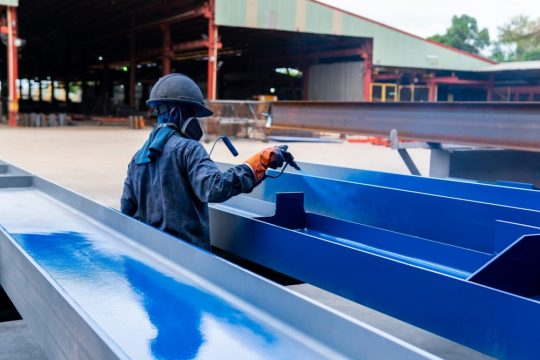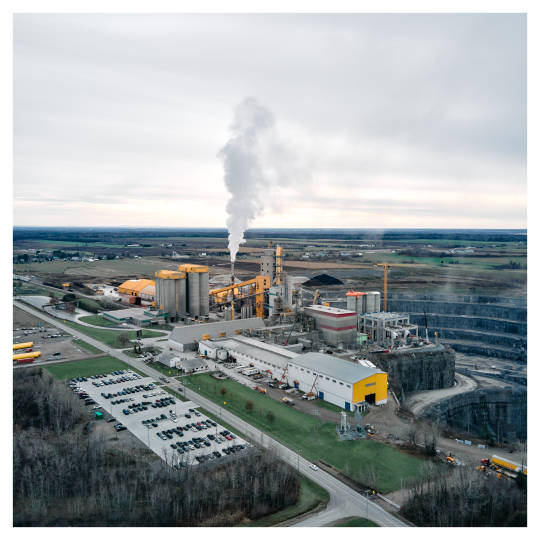#cement plant
Explore tagged Tumblr posts
Text

Sunrise light on steam from the cement plant, January 2022.
210 notes
·
View notes
Text

boulevard du centenaire, saint-basile-de-portneuf
382 notes
·
View notes
Text


saw this freaky cement plant while driving back to flag a few months ago. also very very technically i trespassed while taking these photos
10/20/2024 hopewell mountain, clarkdale, arizona
#photography#structure#cement plant#i think?#idk how to tag this one ngl#arizona#clarkdale#hopewell mountain#of reality
4 notes
·
View notes
Text

Cement Plant in Japan Via: https://www.reddit.com/r/Construction/comments/1e7aser/cement_plant_in_japan_why_does_it_look_so_crazy/
3 notes
·
View notes
Text

0 notes
Text

Sandblasting and Spray Painting Services for Cement Plants
Cement plants operate in extreme environments where machinery, structures, and equipment are constantly exposed to dust, heat, and moisture. Over time, this exposure can lead to corrosion, wear, and deterioration, impacting operational efficiency and safety. Professional sandblasting and spray painting services help cement plants maintain their infrastructure, extend the life of their equipment, and ensure compliance with industry standards.
What is Sandblasting?
Sandblasting, also known as abrasive blasting, is a process where fine particles of abrasive materials are propelled at high velocity onto a surface to remove rust, old paint, dirt, or contaminants. This method ensures a clean and smooth surface, preparing it for protective coatings.
Benefits of Sandblasting for Cement Plants
Removes Rust and Contaminants: Sandblasting eliminates corrosion, scaling, and residues, ensuring a clean surface for painting.
Enhances Coating Adhesion: A roughened surface improves the adhesion of protective coatings, increasing their longevity.
Restores Equipment Efficiency: Clean and well-maintained equipment performs better, reducing maintenance costs and downtime.
Spray Painting for Cement Plants
Spray painting is an advanced coating technique that provides even, durable, and high-quality finishes on large industrial surfaces. For cement plants, specialized industrial coatings are used to protect structures and machinery from corrosion, chemicals, and environmental wear.
Types of Coatings Used
Epoxy Coatings: Highly durable and resistant to chemicals, making them ideal for cement plants.
Polyurethane Coatings: Provide UV resistance and flexibility, preventing cracking and peeling.
Zinc-Rich Primers: Offer corrosion resistance, especially for steel structures exposed to moisture.
Advantages of Spray Painting in Cement Plants
Uniform and Smooth Finish: Ensures even coverage, reducing surface imperfections.
Fast Application: Efficiently covers large areas, minimizing downtime.
Long-Lasting Protection: Increases resistance against environmental damage and chemical exposure.
Why Choose Cement Plant Painters?
Cement plant painters specialize in surface preparation and coating applications tailored to industrial environments. Their expertise ensures that:
Surfaces are thoroughly cleaned and prepared before painting.
The right protective coatings are applied based on environmental conditions and material requirements.
All work complies with industry regulations and safety standards.
Enhance Durability with Expert Sandblasting and Spray Painting
Regular maintenance and protective coatings are essential for cement plants to function efficiently. Professional sandblasting and spray painting services extend the life of industrial equipment, improve safety, and maintain aesthetic appeal.
For expert sandblasting and spray painting services, trust experienced professionals who understand the unique challenges of cement plants. Contact Cement Plant Painters today to discuss your project requirements and get a customized solution for your industrial coating needs.
Contact Us:
📍 Address: Cement Plant Painters 📞 Phone: 9845063120 🌐 Website: https://cementplantpainters.com/
#sandblasting#copperslag blasting#Grit blasting#spray painting services#heat resistant paint#cement plant
0 notes
Text
Cement Manufacturing Units in Maharashtra
Maharashtra is a key state for cement production in India. With rich limestone reserves, a strong transport network, and high demand due to rapid urbanization, the state has become a major hub for cement manufacturing. Several leading companies have set up their plants here to meet the growing need for cement in construction and infrastructure projects.

Major Cement Companies in Maharashtra Several well-known cement manufacturers operate in Maharashtra, including:
•Chettinad Cement – A well-established brand known for its high-quality cement and efficient manufacturing processes.
•UltraTech Cement – One of India's largest cement producers with multiple plants in the state.
•Ambuja Cement – Known for quality cement and sustainable production practices.
•ACC Cement – A leading player in the industry with a strong presence in Maharashtra.
•Birla Corporation – Expanding its operations to meet the rising cement demand.
•JSW Cement – A growing brand investing in modern cement production techniques.
Why Maharashtra is a Cement Hub Maharashtra has several advantages that make it a key location for cement manufacturing:
•Abundant Limestone – The state has rich reserves of limestone, the primary raw material for cement production.
•Infrastructure Growth – Rapid construction of roads, bridges, metros, and buildings has increased cement demand.
•Urbanization – Cities like Mumbai, Pune, and Nagpur are growing fast, leading to a higher need for cement in housing and commercial projects.
•Well-Connected Transport System – Maharashtra has an efficient road, rail, and port network, making it easier to transport raw materials and finished products.
Environmental Efforts in Cement Production With increasing concerns about pollution, many cement companies in Maharashtra are adopting eco-friendly practices, such as:
•Using alternative fuels to reduce reliance on fossil fuels.
•Implementing waste heat recovery systems to save energy.
•Producing green cement with lower carbon emissions.
Conclusion Cement manufacturing in Maharashtra plays a crucial role in the state's development. With growing demand and continuous improvements in production techniques, the industry is expected to expand further while adopting more sustainable practices.
If you want more information visit this website
Contact us: 6385 194 588
Facebook https://www.facebook.com/Chettinadcements
Twitter https://x.com/ChettinadCement
Instagram https://www.instagram.com/chettinadcements/profilecard/?igsh=dWg2Y2lwbWNqcTBp
Youtube : https://www.youtube.com/@ChettinadCementIndia/shorts
#Cement plant#Cement Manufacturing#Cement Industries#Cement Distribution#Chettinad cement#Maharashtra
0 notes
Text
तमिलनाडु में टॉप सीमेंट ब��रांड: आपके लिए सबसे अच्छा कौन सा है?
मजबूत और टिकाऊ निर्माण के लिए सही सीमेंट का चयन करना बहुत महत्वपूर्ण है। तमिलनाडु में कई विश्वसनीय सीमेंट ब्रांड उपलब्ध हैं जो घरेलू, व्यावसायिक और औद्योगिक निर्माण के लिए उच्च गुणवत्ता वाले उत्पाद प्रदान करते हैं। यहाँ तमिलनाडु के शीर्ष 5 सीमेंट ब्रांडों की सूची दी गई है।

चेत्तिनाड सीमेंट चेत्तिनाड सीमेंट एक प्रतिष्ठित ब्रांड है जो अपनी उच्च गुणवत्ता और मजबूत पकड़ के लिए जाना जाता है। यह ऊँची इमारतों, औद्योगिक परियोजनाओं और बड़े निर्माण कार्यों में व्यापक रूप से उपयोग किया जाता है। यह अंतरराष्ट्रीय गुणवत्ता मानकों को पूरा करता है और लंबी उम्र के लिए एक बेहतरीन विकल्प है।
अल्ट्राटेक सीमेंट अल्ट्राटेक भारत का एक प्रमुख सीमेंट ब्रांड है, जो तमिलनाडु में भी बहुत लोकप्रिय है। यह पोर्टलैंड और मिश्रित सीमेंट के बेहतरीन प्रकार प्रदान करता है, जो घरों और व्यावसायिक भवनों के निर्माण के लिए एक उत्कृष्ट विकल्प है।
रामको सीमेंट तमिलनाडु का एक स्थानीय लेकिन विश्वसनीय ब्रांड, रामको सीमेंट अपनी उच्च संपीड़न शक्ति (कंप्रेसिव स्ट्रेंथ) और मौसम प्रतिरोधी विशेषताओं के लिए जाना जाता है। यह ओपीसी, पीपीसी और एसआरसी जैसे विभिन्न प्रकारों में उपलब्ध है, जिससे यह घरों और बड़े निर्माण कार्यों के लिए एक उपयुक्त विकल्प बनता है।
डेलमि��ा सीमेंट डेलमिया सीमेंट अपने पर्यावरण-अनुकूल और उच्च स्थायित्व वाले पीपीसी, पीएससी और मिश्रित सीमेंट के लिए प्रसिद्ध है। यह औद्योगिक, सरकारी और आवासीय परियोजनाओं में व्यापक रूप से उपयोग किया जाता है और दीर्घकालिक मजबूती और स्थिरता प्रदान करता है।
इंडिया सीमेंट्स इंडिया सीमेंट्स तमिलनाडु में एक मजबूत बाजार पकड़ रखता है, विशेष रूप से इसका प्रमुख ब्रांड "कोरोमंडल सीमेंट" अत्यधिक लोकप्रिय है। यह छोटे घरों से लेकर बड़े व्यावसायिक निर्माण कार्यों तक गुणवत्ता और विश्वसनीयता प्रदान करता है।
आपके लिए कौन सा सीमेंट सबसे अच्छा है?
•घर के निर्माण के लिए: चेत्तिनाड, अल्ट्राटेक या रामको सीमेंट अच्छे विकल्प हैं।
•बड़े निर्माण प्रोजेक्ट्स के लिए: चेत्तिनाड, इंडिया सीमेंट्स या रामको सीमेंट मजबूत और टिकाऊ हैं।
•पर्यावरण-अनुकूल निर्माण के लिए: डेलमिया और चेत्तिनाड सीमेंट सर्वोत्तम विकल्प हैं।
निष्कर्ष एक मजबूत और टि��ाऊ संरचना सुनिश्चित करने के लिए सही सीमेंट ब्रांड का चयन करना आवश्यक है। अपनी जरूरतों के अनुसार, मजबूती, स्थायित्व, मौसम प्रतिरोध और स्थिरता को ध्यान में रखते हुए सीमेंट का चयन करें। चाहे आप घर बना रहे हों या कोई व्यावसायिक प्रोजेक्ट, तमिलनाडु के ये शीर्ष सीमेंट ब्रांड आपके निर्माण को मजबूती और गुणवत्ता प्रदान करेंगे।
If you want more information visit this website
Contact us: 6385 194 588
Facebook https://www.facebook.com/Chettinadcements
Twitter https://x.com/ChettinadCement
Instagram https://www.instagram.com/chettinadcements/profilecard/?igsh=dWg2Y2lwbWNqcTBp
Youtube : youtube.com/@ChettinadCementIndia/shorts
0 notes
Text
Considerations for Cement Cooling Processes
In cement production, the cooling process plays a crucial role in ensuring the quality and performance of cement. The cement cooling process mainly consists of two methods: online cooling and post-storage cooling. The latter method is particularly suitable for processes that require strict temperature control due to its large cooling range and controllable temperature. To ensure effective cooling and the normal operation of equipment, it is essential to pay attention to several key issues during application.

1. Local Cooling Issues
When using a single silo cooling process, cement exits the silo, enters the cooler, and then returns to the same silo via an elevator. This method may lead to a situation where the cooler's discharge temperature meets the requirements, but the temperature of the material released from the silo remains high and does not meet standards. The root cause of this phenomenon lies in the formation of a material flow channel between the silo's entrance and exit. Since the material flows continuously in and out, other materials in the silo cannot enter this channel, resulting in rapid cooling of the material in the channel while the rest remains inadequately cooled.
To solve this problem, I recommend using a dual-silo process. Specifically, the material from one silo passes through the cooler and enters another silo. If the temperature still does not meet the requirements, the material can be released from the second silo and returned to the first silo for a cyclical operation. This method effectively improves cooling efficiency and ensures that the cement temperature meets the standards.
2. Cement Caking Issues
During storage, temperature differences often cause cement to cake on the walls of the silo, especially in steel silos. As the cement level decreases, some of these caked materials may fall off and enter the cooler along with the cement. The accumulation of these caked materials can affect the moving parts inside the cooler and may lead to mechanical failures.
To address this issue, I suggest installing equipment to remove cement caking before the cooler or setting up inspection ports at appropriate locations on the cooler. This allows for regular cleaning of the caked cement, ensuring the normal operation of the equipment.
3. Expansion Box Issues
The expansion box phenomenon occurs when cement fills the cooler's housing. Mechanical action causes the cement to expand, leading to deformation of the cooler's housing and potentially causing blockages or damage to mechanical parts. This situation primarily arises when the discharge amount from the silo exceeds the processing capacity of the cooler or elevator.
To resolve this issue, I recommend installing flow-stabilizing feeding equipment under the silo. This ensures that the discharge amount does not exceed the processing capacity of the cooler and elevator, thereby avoiding overload situations.
Conclusion
The external circulation cooling process of cement silos plays a vital role in cement production. Through proper process design and equipment maintenance, we can effectively enhance cooling efficiency and ensure cement quality. I hope the above suggestions provide valuable insights for industry professionals and contribute to the smooth operation of cement production.
If you would like to learn more about the external circulation cooling process of cement silos or have any questions, please feel free to contact us. We look forward to providing you with professional support and services!
0 notes
Text
How to Get the Right Cement and Sand Ratio for Floor Plastering
Floor plastering is important in providing a smooth and hard-wearing surface that can easily cope with normal traffic. The right cement plastering ratio is crucial to obtain the right strength and workability that will enable one to obtain a high-quality finish.
This guide will guide you on how to calculate the correct cement and sand ratio for plastering and also explain the importance of using such specialized products as roof special cement and ready-mix concrete.
Why the Cement Plastering Ratio is Important
Cement plastering ratio is the ratio of cement, sand, and water used in cement plastering work. This ratio is important in determining the right proportion of strength, workability, and durability of the concrete. For floor plastering, the typical ratio ranges between 1:The ratio of cement to sand used in the process is 1:4 and 1:6 depending on the nature of the surface to be treated.
A stronger mix, such as 1:4, is suitable for areas with much traffic or loads while a 1:6 ratio is suitable for normal residential floors.
The Cement Sand Water Ratio for Plastering: A Guide
As important as the cement sand water ratio for plastering is the right consistency of the mix. Excess water in the plaster mix can lead to shrinkage cracks while a shortage of water makes the mix difficult to apply. The ideal is to achieve a workable blend that will stick well to the surface of the material.
Selection of the Right Material for Floor Plastering
Best Cement for Roof Slab and Floors
Although the best cement for roof slabs is developed for roof construction, it is also strong and durable for floor plastering. High-quality cement is used to guarantee a strong surface that cannot crack or wear out easily.
Roof Special Cement
Roof special cement is another good material for floor plastering particularly in the areas of the house that are frequently exposed to moisture. It also does not easily get affected by dampness hence making the surface last longer.
Ready Mix Concrete
Ready-mix concrete is useful for large projects or where time is an issue. It provides uniformity in quality and does not require on-site mixing, thus saving time and costs on labor and materials.
How to Achieve the Correct Cement and Sand Ratio for Plastering
Identify the Surface Needs: Determine the type of floor and its application. High-traffic areas or industrial floors may require a stronger cement and sand ratio for plastering, such as 1:4, for added durability.
Measure the Materials: Ensure you measure the right proportions of cement and sand as required in the process. For instance, if using a 1:4 ratio, you will require one part of cement and four parts of sand in the mixture.
Mix Dry Ingredients: The cement and sand must be blended well in their dry form to avoid any uneven distribution. This step is crucial for getting a smooth plaster surface.
Add Water Gradually: Gradually add water to get the right texture of the dough. The correct cement-sand-water ratio for plastering should produce a material that can be easily applied but not very sloppy.
Apply the Plaster: Level the mix on the floor using a trowel so that it has an even thickness all over the floor. Apply in small portions to prevent it from hardening before it is leveled.
Curing: Curing of the plaster is very important in order to achieve strength and durability of the plaster. It is recommended that the surface should remain wet for at least 7 days so that the cement can be fully hydrated.
Advantages of Employing High-Quality Material
Strength and Durability: The correct cement plastering ratio along with good quality material gives a good surface that is long-lasting.
Moisture Resistance: Roof special cement or ready mix concrete that has water resistance eliminates problems such as dampness and mold formation.
Smooth Finish: The right combination and application give a perfect surface that improves the outlook of the floor.
Conclusion
The cement and sand ratio for plastering is important in determining the success of the floor plastering project. Knowing the correct cement plastering ratio and using high-quality materials such as roof special cement or ready-mix concrete gives a long-lasting and smooth surface that is suitable for everyday use. By following these steps, you will have a professional quality floor plaster that will last for years in your residential or commercial project.
#cement#सीमेंट#cement company#cement manufacturers#cement factory#bulk cement#cement plant#online cement#cement wholesale price#cement best quality#good quality cement#cement plastering#Prism Cement#Prism
1 note
·
View note
Text

Demech Chemical Products Pvt. Ltd. has developed an external tank Coating system in order to protect the very valuable assets for a very long period of time. Tanks are a very important asset for any industry for storing of various solutions /gases such as crude oil , finished products like petrol, diesel, ATF, portable water, edible oil etc. For more details visit https://lnkd.in/e7rRjFb5 or call @ 8240281662 or mail us on [email protected]
#tankcoating#portable water#demechchemical#extenaltankcoating#TankBootSealing#anticorrosion#protect#prevent#prolong#oil and gas#ceramic coating#cement plant#power plant
0 notes
Text

boulevard du centenaire, saint-basile-de-portneuf
35 notes
·
View notes
Text
How to Damp Proof and Protect Your Home from Water Seepage
Damp proofing your home is not just about fixing issues after they occur, but also about proactive prevention. By using the best cement produced in one of the most Technologically Advanced Cement Plant and ensuring proper waterproofing techniques, you can protect your home from the damaging effects of water seepage and dampness.
0 notes
Text
The Indian Cement Industry: A Foundation for Growth
The Indian cement industry is a cornerstone of the nation's infrastructure development. This blog dives into the landscape of the Indian cement sector, exploring major players like UltraTech Cement and JSW Cement, alongside market trends, product offerings (OPC cement etc.), and pricing. Discover the key factors driving the growth of the Indian cement industry and its impact on the nation's development.

#Cement Industry Growth#Cement Company#Portland Cement#Cement Price#Cement Plant#Cement Factory#Cement Manufacturing#Cement Suppliers#OPC Cement#Ultratech Cement Price#Cement Products#JSW Cement Price#Birla Cement#Cement Market India#Cement Industry India#Cement Sector India
1 note
·
View note
Text

0 notes
Text

KITTY CLAWS. 5 STINGS.
#MY FRIEND: bulk and prowl his living scratchposts#LOVE IT#the real reason they have a cement sofa at the plant is because bee could not be trusted with actual couches after 1 time (him finding out#he can have stinger claws)#bumblebee#transformers animated#tfa#maccadam#scriboozles
148 notes
·
View notes